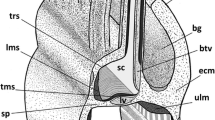Summary
The nuchal organ ofEurythoë complanata is characterized by the following cell types:
-
1.
Columnar supporting cells without cilia, between the microvilli of which layers of electron-dense filaments are deposited, which are orientated at right angles over each other.
-
2.
Ciliated cells, which contain smooth-surfaced E. R. tubules in their apical part. At their bases they are in close contact with synapses. They presumably serve the perception of olfactory stimuli.
-
3.
Cells with extensive systems of smooth endoplasmic reticulum which are often associated with pigment cells. They are interpreted to represent light-sensitive cells.
-
4.
Mucus producing cells.
The basement membrane exhibits in regular intervals peculiar, relatively tall up-foldings which distally extend into clubshaped inflations. Over their tips are running nerve-fibres often containing dense vesicles, which may give responses to mechanical stimuli.
Zusammenfassung
Das Nuchalorgan vonEurythoë complanata ist durch folgende Zelltypen gekennzeichnet:
-
1.
Hochprismatische Stützzellen ohne Zilien, zwischen deren Mikrovilli rechtwinklig gegeneinander versetzte Schichten elektronendichter Filamente liegen.
-
2.
Zilientragende Zellen, in deren distalen Bereichen glattwandige Tubuli und Zisternen liegen. Basal sind sie mit Synapsen besetzt. Diesen Zellen wird Chemorezeption zugeschrieben.
-
3.
Zellen mit umfangreichem endoplasmatischem Retikulum, in deren Nachbarschaft oft pigmenthaltige Zellen liegen. Diesem System wird Lichtrezeption zugeschrieben.
-
4.
Schleimzellen.
Die Basalmembran ist in regelmäßigen Abständen verstärkt und sendet Ausläufer bis fast unter die Epitheloberfläche. Auf diesen Basalmembranauffaltungen lagern oft Nerven, die möglicherweise auf mechanische Beanspruchung reagieren.
Similar content being viewed by others
Literatur
Andres, K. H.: Der olfaktorische Saum der Katze. Z. Zellforsch.96, 250–274 (1969).
Brökelmann, J., u.A. Fischer: Die Cuticulastruktur vonPlatynereis dumerilii (Polychaeta). Z. Zellforsch.70, 131–135 (1966).
Dorsett, D. A., andR. Hyde: Fine structure of Nereid Sense Organs. Z. Zellforsch.97, 512–527 (1969).
Gustafson, G.: Anatomische Studien über die Polychaetenfamilien Amphinomidae und Euphrosynidae. Zool. Bidr. (Uppsala)12, 305–471 (1930).
Hempelmann, F.: Polychaeta. In:Kükenthal, Handbuch der Zoologie, Bd. 2. 212 pp. Berlin: W. de Guyter & Co. 1931.
Jeener, R.: Recherches sur le système neuro-musculaire latéral des Annélides. Rec. Inst. Zool. Torley Rousseau (Bruxelles)4, 99–121 (1927).
Lawry, J.: Structure and function of the parapodial cirri of the polynoid polychaeteHarmothoe. Z. Zellforsch.82, 345–361 (1967).
Malaquin, A., etA. Dehorne: L'encéphale de Notopygos labiatus. C. R. Ass. franç. avanc. Sci. (Paris)36, 691–696 (1907).
Moody, M. F., andJ. D. Robertson: The fine structure of some retinal photoreceptors. J. biophys. biochem. Cytol.7, 87–92 (1960).
Porter, K. R., andE. Yamada: Studies on the endoplasmic reticulum V. Its Form and differentiation in pigment epithelial cells of the frog retina. J. biophys. biochem. Cytol.8, 181–205 (1960).
Racovitza, E. G.: Sur le lobe céphalique des Euphrosines. C.R. Acad. Sci. (Paris)119, 1226–1228 (1895).
—: Le lobe céphalique et l'encéphale des Annélides polychètes. Arch. zool. exp. gén. (Paris)4, 133–343 (1896).
Rullier, F.: Etude morphologique, histologique et physiologique de l'organ nucal chez les Annélides Polychètes sédentaires. Ann. Biol.27, 51–56 (1951).
—: L'organe nucal deSthemlais boa. C.R. Acad. Sci. (Paris)238, 1351–1353 (1954).
Söderström, A.: Studien über die Polychaetenfamilie Spionidae. Diss. Uppsala: Almquist & Wicksells 1920. 286 pp.
Storch, O.: Zur vergleichenden Anatomie der Polychäten. Verh. zool.-bot. Ges. Wien62, 81–97 (1913).
Welsch, U., u.V. Storch: Über das Osphradium der prosobranchen SchneckenBuccinum undatum L. undNeptunea antiqua (L.). Z. Zellforsch.95, 317–330 (1969)
Author information
Authors and Affiliations
Additional information
Die Untersuchungen wurden mit dankenswerter Unterstützung durch die Deutsche Forschungsgemeinschaft ausgeführt.
Herrn Prof. Dr.W. Bargmann danke ich für einen Arbeitsplatz im elektronenmikroskopischen Laboratorium des Anatomischen Instituts Kiel.
Rights and permissions
About this article
Cite this article
Storch, V., Welsch, U. Zur Feinstruktur des Nuchalorgans vonEurythoë complanata (Pallas) (Amphinomidae, Polychaeta). Z.Zellforsch 100, 411–420 (1969). https://doi.org/10.1007/BF00571495
Received:
Issue Date:
DOI: https://doi.org/10.1007/BF00571495




